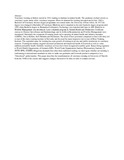| dc.contributor.author | Njenga, Munene J | |
| dc.date.accessioned | 2014-07-11T06:12:21Z | |
| dc.date.available | 2014-07-11T06:12:21Z | |
| dc.date.issued | 2010 | |
| dc.identifier.citation | Njenga Munene J,Veterinary Education And Training:Remaining Relevant In Changing Demands For Veterinary Service Delivery,Proceedings Of The 7th Biennial Scientific Conference September 8th To 10th 2010 | en_US |
| dc.identifier.uri | http://hdl.handle.net/11295/72640 | |
| dc.description.abstract | Veterinary training at Kabete started in 1942, leading to diploma in animal health. The graduates worked strictly as veterinary scouts under white veterinary surgeons. However demand for training increased and in July 1962 a Bachelor of Veterinary Science degree programme was started under the University of East Africa. In 1972 the degree was changed to Bachelor of Veterinary Medicine and it remained as the only bachelor degree program until 1999 when Bachelor degree in Biomedical Laboratory Technology was launched and later in 2001 Bachelor in Wildlife Management was introduced. Later a diploma program in Animal Health and Production, Certificate courses in Disease Surveillance and Epidemiology and in Artificial Insemination and Fertility Management were introduced. Nationally the expansion of training needs led to opening of animal health and industry institutes (AHITIs), first at Kabete, then Ndomba and Nyahururu. The need to have personnel competent to deal with dairy led to start of the dairy training institute in Naivasha and the need for meat inspectors led to start of Meat Training Institute. The expanded space for training has seen growth of training in private and public institutions in veterinary sciences. Training has mainly targeted increased production and improved health of livestock as well as value addition and public health. Globally veterinary services have been recognized as public good. Kenya being signatory to World Health Organisation of Animals (OIE), World Trade Organisation-Sanitary Phytosanitary Sanitary 34
(WTO-SPS), CODEX obligations demands that other than traditional training we interrogate whether our training is conforming to international standards in order to make our graduates and livestock products competitive in a “liberalized” global market. This paper describes the transformation of veterinary training in University of Nairobi from the 1940s to the current and suggests changes that need to be done in order to remain relevant. | en_US |
| dc.language.iso | en | en_US |
| dc.publisher | University Of Nairobi | en_US |
| dc.title | Veterinary Education And Training:Remaining Relevant In Changing Demands For Veterinary Service Delivery | en_US |
| dc.type | Presentation | en_US |
| dc.type.material | en | en_US |

